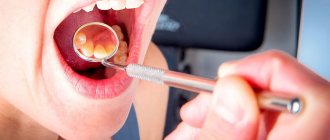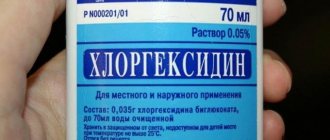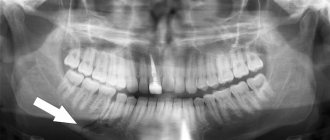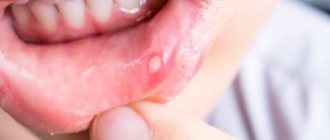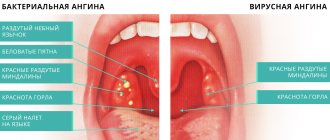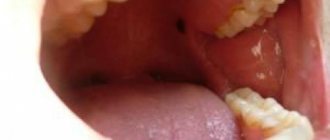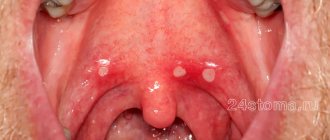Mucositis and peri-implantitis are periodontal diseases in the area of dental implants. In their manifestations, these diseases are very similar to periodontal diseases in the dental area, such as gingivitis and periodontitis, which is clearly visible in the illustrations above, but, due to the structural features of the soft tissues around the implant, mucositis and peri-implantitis differ from gingivitis and periodontitis in the nature of the course of the disease, therefore, a different treatment tactic is chosen.
Mucositis is inflammation of the mucous membrane in the area of a dental implant without signs of bone loss (clinical signs similar to gingivitis).
| Gingivitis | Mucositis |
Peri-implantitis is an inflammatory disease of soft tissue in the implant area, accompanied by bone resorption (loss) (clinical signs similar to periodontitis).
| Periodontitis | Peri-implantitis |
The disease is determined during a follow-up examination at the dentist using probing of the gum pockets and x-rays.
Description of the pathology
Oral mucositis is an inflammatory process in soft tissues, in which painful bleeding ulcers appear on the mucous membrane. Erosions form on the gums, inner surface of the cheeks and tongue.
This disease causes severe discomfort. It becomes painful for the patient to drink and eat. The person begins to avoid food and liquid intake, which leads to severe weight loss, exhaustion and dehydration.
Mucositis of the oral mucosa is a dangerous disease. If left untreated, ulcerative inflammation can spread to the throat and gastrointestinal tract. In addition, bacteria and fungi can get into bleeding wounds. This leads to worsening of the inflammatory process, suppuration, and sometimes to sepsis.
Reviews
Oral mucositis is a fairly common phenomenon that occurs in patients undergoing cancer treatment.
Proper oral hygiene, a properly selected diet and timely administration of medications can quickly relieve the painful syndrome and prevent the progression of the disease.
If you have had to deal with mucositis of the oral mucosa, share your experience of getting rid of the disease in the comments to the article.
If you find an error, please select a piece of text and press Ctrl+Enter.
Tags medicines oral cavity
Did you like the article? stay tuned
No comments yet
Etiology
Mucositis most often develops after chemotherapy. This is the body’s reaction to the action of drugs used in oncological practice. High doses of anticancer drugs negatively affect not only cancer cells, but also healthy tissue. Mucositis may also appear after radiation therapy for cancer.
In more rare cases, the following factors can trigger the development of mucositis of the oral mucosa:
- decreased immunity after infections;
- chronic stomatitis;
- oral thrush;
- caries;
- metabolic disorders;
- pathologies of the gastrointestinal tract;
- complications after bone marrow transplantation;
- frequent irritation of the mucous membrane with hot food and liquid;
- smoking.
Mucositis can also develop after taking certain medications. We have already mentioned that taking antitumor drugs can lead to inflammation and ulceration of tissues. However, any cytostatics and immunosuppressants can provoke the occurrence of mucositis. Such drugs are prescribed, for example, for autoimmune diseases. These drugs weaken the body's defenses and reduce the number of beneficial bacteria in saliva.
Mucositis usually occurs within 2-3 weeks after starting medication. If the patient does not have any symptoms in the mouth within a month, then most likely the pathology will not develop.
Risk factors for developing mucositis
- Failure of metabolism, disturbances in the gastrointestinal tract;
- weakened immunity due to past illnesses;
- stomatitis in the chronic stage;
- untimely treatment of dental diseases;
- allergies to medications: antitumor antibiotics (Mitomycin, Vinblastine, Dactinomycin);
- antimetabolic drugs (Thioguanine, Fluuracil, Cytarabine);
- alkylating drugs (Cyclophosphamide, Cisplatin, Temodal).
ICD code
According to the International Classification of Diseases, oral mucositis refers to pathologies of the oral cavity, jaw and salivary glands (divisions K00-K14). This disease is considered as a lesion related to stomatitis (code K12). The full ICD-10 code for mucositis is K12.3.
This only applies to oropharyngeal mucositis. If the ulcerative process has already spread to the gastrointestinal tract, then a different code is used. The code for mucositis of the gastrointestinal tract is K92.8. This disease is considered as one of the pathologies of the digestive organs.
Symptoms
The first sign of the disease is redness of the mucous membrane. Then rashes appear on the affected areas, resembling herpes blisters. Over time, they become ulcerated. The pathology is accompanied by other symptoms:
- redness of the mucous membrane;
- severe itching;
- dry mouth;
- pain during talking and eating;
- the appearance of white spots on the affected areas;
- a slight but constant increase in temperature.
If a patient experiences dyspeptic disorders, this may be the first sign of gastrointestinal mucositis. What it is? As already mentioned, the pathological process can spread to the digestive organs; this is considered a gastrointestinal form of pathology. The following symptoms indicate this complication:
- diarrhea;
- the appearance of bloody and mucous impurities in feces;
- frequent abdominal pain.
With such a clinical picture, the patient needs emergency help. In advanced cases, diarrhea gives way to intestinal obstruction, and the patient may die from peritonitis.
Gastrointestinal mucositis during chemotherapy can develop as an independent disease. Pathology does not always begin in the oral cavity. In some cases, inflammation and ulcers immediately form in the gastrointestinal tract, and no damage to the oral cavity is noted.
Drugs that cause
It has been proven that some drugs (cytostatics) have a negative effect on the cells of the basal layer of the epithelium. Medicines destroy them, leaving behind ulcers on the mucous membranes.
Drugs that have a toxic effect include:
- doxorubicin, epirubicin;
- cyclophosphamide, procarbazine, embiquin and other alkylating agents;
- taxane group;
- antibiotics used in oncology;
- vinca alkaloids;
- antimetabolites: fluorouracil, thioguanine and others.
All these drugs and medications belonging to the above groups cause collagen destruction and epithelial dysplasia in the oral cavity.
Under their influence, cells of the immune system are suppressed, saliva loses its protective properties, and the mucous membrane suffers.
Stages of oral lesions
There are several stages of mucositis. What it is? The pathological process in the oral cavity develops in stages. The stage of the disease depends on the degree of tissue damage and the severity of pain. Each stage of pathology development is characterized by its own symptoms:
- Zero stage. This stage of the disease is considered the incubation period. The pathology is already developing, but the patient does not yet feel any symptoms.
- First stage. There is redness in some areas of the oral cavity. Single ulcers may be observed. There is no pain while eating yet.
- Second stage. Multiple erosions appear in the mouth. While eating, a person feels discomfort, but this does not prevent the patient from eating.
- Third stage. The ulcers increase in size and become deeper. Sometimes minor bleeding is observed. Large pockets of inflammation form in the mouth. At first, a person experiences discomfort when speaking. Then there is severe pain while eating. Because of this, the patient can only take liquid and pureed food. Eating solid food becomes impossible.
- Fourth stage. Most of the mucous membrane is covered with ulcers and inflamed. The patient experiences pain even when drinking liquid. There is severe weight loss and dehydration. Ulcers often bleed.
Advanced stages of mucositis of the oral mucosa pose a danger to human life and health. The patient may die from lack of food and dehydration. In such cases, the patient is transferred to feeding through a tube.
Causes of mucositis after implantation
In the oral cavity, the disease usually develops due to chemotherapy or improper implantation. The following medical errors can provoke the appearance of mucositis:
- Incorrectly selected dental implant. Leads to uneven load and loosening of the abutment. Subsequently, the load on the bone increases, inflammation appears, and the hard jaw structures lose volume.
- Gaps between the abutment and the implant or crown. The joints are most vulnerable to bacterial penetration. It is very difficult to achieve absolute tightness, so implant manufacturers are constantly improving the connection system.
- Excessive screwing of the implant into the bone can lead to its destruction.
- Infection during surgery.
- Incorrect calculation of loads on the prosthesis and implant.
- Incomplete patient history.
- Inappropriate prosthetic technique - the success of the operation depends on the qualifications and experience of the specialist.
- Inadequate oral hygiene in the postoperative period.
- Periodontitis and pyorrhea are diseases that lead to inflammation of the tissue around the crown.
- Nicotine addiction.
Degrees of damage to the gastrointestinal tract and toxicity criteria
Mucositis of the mucous membrane of the gastrointestinal tract also develops in stages. The following stages of development of the pathological process can be distinguished:
- Stage 1. There are no pronounced symptoms of gastrointestinal tract damage. Mild diarrhea may occur occasionally.
- Stage 2. Abdominal pain occurs. Stools become frequent (4-6 times a day) and liquid, blood and mucus appear in the feces.
- Stage 3. The frequency of stool reaches 8 or more times a day. The patient is constantly experiencing severe abdominal pain. The temperature rises sharply. In some cases, initial signs of intestinal obstruction are observed.
- Stage 4. Dead areas appear on the gastrointestinal mucosa. Frequent bleeding is observed; in severe cases, perforation of the intestinal wall and the development of peritonitis are possible. Without emergency medical care, the patient dies.
Doctors also consider the degree of toxicity associated with mucositis. What it is? If an ulcerative process has developed after taking cytostatics, then it is necessary to assess the level of negative effects of the drugs on the organs. In this case, the main criterion is the severity of diarrhea:
- 1st degree. The volume of feces ranges from 500 ml to 2 liters per day.
- 2nd degree. The volume of feces is more than 2 liters per day. Blood and mucus appear in the stool.
- 3rd degree. Intestinal obstruction develops, which requires surgical intervention. There are signs of severe colitis with frequent bleeding.
Mucositis after chemotherapy is especially dangerous. After all, the patient’s body is greatly weakened by cancer and the use of cytostatics. Without treatment, advanced forms of pathology often lead to death.
Mucositis and peri-implantitis: symptoms
The development of mucositis and peri-implantitis is associated with an infectious process. Microbiological studies have shown that they are most often caused by pathogenic microorganisms such as spirochetes and gram-negative anaerobes. In particular, these include Treponema denticola, Prevotella intermedia, Prevotella nigrescens, Porphyromonas gingivalis, Aggregatibacter actinomycetemcomitans, Bacterioides forsythus, Fusobacterium nucleatum.
Making a diagnosis - the diagnosis is made on the basis of an external examination, probing of the gum pocket, as well as X-ray data. With mucositis, swelling, redness or bluishness of the gums around the implant is observed, and bleeding occurs when probing the gum pocket. In this case, there are no signs of bone loss on x-rays.
If peri-implantitis has developed, the symptoms (in addition to swelling, redness or cyanosis of the gums, bleeding when probing the gums - characteristic of mucositis) will also include...
- discharge of purulent or serous exudate from the gingival pocket and/or fistula,
- probing depth of the gingival pocket is at least 5-6 mm,
- X-rays will show bone loss around the implant.
Photo of a patient with peri-implantitis of the lateral incisor of the HF –
Advertising
Important: according to various authors, the normal level of bone loss around the implant is considered to be a bone loss of 1.0-1.5 mm during the 1st year, and then no more than 0.2 mm per year for all subsequent years (time is considered from the moment of loading on the implant, i.e. from the moment of prosthetics). Any amount of bone tissue resorption above these indicators is considered pathological.
However, it should be noted that a number of the most modern implants make it possible to completely avoid programmed reduction in bone tissue levels. These include the following implant manufacturers: Straumann (Switzerland), AstraTech (Sweden), NobelBiocare (Switzerland).
Diagnostics
The dentist treats this disease. If the pathology arose as a result of chemotherapy, then it is necessary to report the occurrence of undesirable symptoms to the treating oncologist. If the gastrointestinal tract is affected, consultation with a gastroenterologist will be required.
Mucositis in its manifestations resembles many other dental pathologies, for example, aphthous stomatitis, which is also accompanied by the appearance of ulcers. For the purpose of differential diagnosis, the patient may be prescribed the following examinations:
- examination of the oral cavity;
- blood test for leukocytes and ESR;
- swab from the mouth for bacterial culture;
- MRI or CT scan of affected tissues.
Treatment of peri-implantitis: how to save an implant
Let us warn you right away: you can save an implanted tooth only if the implant is motionless. Before starting treatment, it is necessary to neutralize the excessive load on the implant. Healthy Dent dentistry provides treatment according to the following protocol:
- Cleaning the implant: bacteria are removed from the surface of the implant. For this purpose, mechanical cleaning is used - curettage, ultrasound, erbium laser, Air Flow method.
- Antibacterial therapy: the patient is prescribed a course of antibiotics.
- Surgical method: a flap of gum is peeled off and necrotic tissue and granulations are removed.
- Aesthetic surgery: performed when indicated to increase the width and thickness of the gums, deepen the vestibule of the oral cavity, plastic surgery of the lip frenulum.
Inflammation after implantation is a very unpleasant and dangerous problem. However, if you immediately contact the dentist for help, there is every chance of saving the implanted tooth.
Therapy
Treatment of mucositis must be comprehensive. It's not just taking medications that is necessary. It is very important to carefully care for the oral mucosa, otherwise the ulcers may become infected. The patient experiences great difficulty while eating, so it is necessary to organize gentle nutrition for him.
When the mouth is affected, the following groups of medications are prescribed:
- Antiseptics: Chlorhexidine solution, Oralsept and Tantum Verde sprays. These medications are used for rinsing and irrigation. They reduce pain and also prevent bacteria from entering wounds.
- Ointments with aloe extract. They are used for compresses and applications. Aloe has wound healing and anti-inflammatory properties. This is an effective and safe remedy.
- Amino acids. Glutamine-based medications are prescribed. This substance stimulates the formation of protein and promotes the healing of ulcers. These medications are available in tablet form.
- Protein preparations: “Filgrastim”, “Kepivance”. These medications are given intravenously or subcutaneously. They can only be used in a hospital setting. They promote tissue healing and restoration.
- Corticosteroid ointments and solutions. The most commonly prescribed drugs are dexamethasone. Locally acting steroid hormones can quickly relieve inflammation. However, such drugs should be used with caution, as they reduce immunity.
- Local anesthetics: Lidocaine, Trimecaine. Prescribed for severe pain.
If the patient has signs of damage to the gastrointestinal tract (diarrhea, abdominal pain), then the following medications are indicated:
- Antibiotics and antiprotozoal drugs: Vancomycin, Ciprofloxacin, Trichopolum. These remedies help prevent the development of infection in the intestines.
- The drug "Sulfasalazine". This medicine has a strong anti-inflammatory effect.
- Antacid "Omez". The drug relieves pain.
- Adsorbents. The most effective drug is Neointestopan. It quickly reduces diarrhea and removes harmful substances from the body.
Conservative methods help only in the early stages of gastrointestinal mucositis. If the patient experiences severe bleeding and intestinal obstruction, surgical intervention is indicated.
Diet
During treatment for oral mucositis, it is very important to follow a gentle diet. The patient experiences severe pain while chewing food. Therefore, all irritating foods should be excluded from the diet:
- solid food;
- alcohol;
- hot and sour dishes;
- too hot and too cold food;
- high-calorie foods.
You should give preference to light foods that are quickly digested. It is recommended to include steamed vegetables and meat in the menu. They should be eaten pureed. Food should be at room temperature.
If it is difficult for the patient to eat even gentle food, then feeding through a tube or parenteral administration of solutions is indicated. Such procedures are carried out in a hospital setting.
Oral care
Mucositis is often complicated by bacterial inflammation. Mouth ulcers are entry points for pathogenic microorganisms. Therefore, it is very important for the patient to observe the following hygiene rules:
- Use a brush with very soft bristles to clean your teeth.
- Temporarily stop wearing dentures, as they further injure the oral cavity.
- Rinse your mouth with antiseptics several times a day.
- Teeth must be cleaned of plaque and food debris after each meal.
- Treat the skin of your lips with special balms to moisturize. This will help prevent cracks from appearing.
In addition, during treatment you should try to drink more clean water (at least 2 liters per day). This will help remove toxins from the body. If the patient has difficulty swallowing, then the liquid should be consumed in small portions, but as often as possible.
Prevention
How to prevent the occurrence of unpleasant manifestations of mucositis? If the patient is to undergo chemotherapy, it is necessary to treat caries in advance. It is also very important to carefully monitor the cleanliness of the oral cavity while taking cytostatics. Any neglect of personal hygiene while taking anticancer drugs can cause an inflammatory and ulcerative process.
During chemotherapy, trauma to the oral cavity should be avoided. You should not chew hard pieces of food, consume hot food and drinks, or use sharp toothpicks. Damage to the mucosa during the course of treatment can lead to the appearance of ulcers and the development of mucositis. During treatment with cytostatics, you must inform your doctor about any inflammation or discomfort in the oral cavity.
Risks of implant rejection in the postoperative period
After successful dental implantation and after the implants have fully fused with the bone (that is, after six months to a year), you still shouldn’t relax. It is important to maintain good oral hygiene and maintain your health. It is clear that no one is immune from developing any disease in the future, but if you have chronic problems, you need to ensure that they do not develop into an acute stage. For example, if you have diabetes, you need to follow a diet and take all medications prescribed by your doctor, and monitor your blood sugar levels.
Immediately after installation of the implants, it is necessary to strictly follow the doctor’s recommendations in terms of therapeutic treatment. If antibiotics have been prescribed, then you must take them for a strictly specified amount of time or at least ask your doctor if you can stop taking them.
If the prosthesis was installed immediately, then you can also eat right away. But the load should be moderate - you can’t go to a restaurant on the first day and eat a hard steak, snacking on nuts and drinking a glass of whiskey.
Read our useful article about how to behave after dental implantation >>>
After 1.5 years, Alexander went to the clinic to replace the adaptive prosthesis with a permanent one made of ceramic composite. During this time, he regularly underwent preventive examinations and paid attention to oral hygiene, so there were no complications after implantation.
View review
“It’s been a year since I lost my teeth. I am happy with everything! My situation was very difficult and serious; I had to remove eight teeth at once. Thanks to the doctors for returning me to normal life. I eat, chew normally, and smile!” – our patient shared his impressions.
View review

